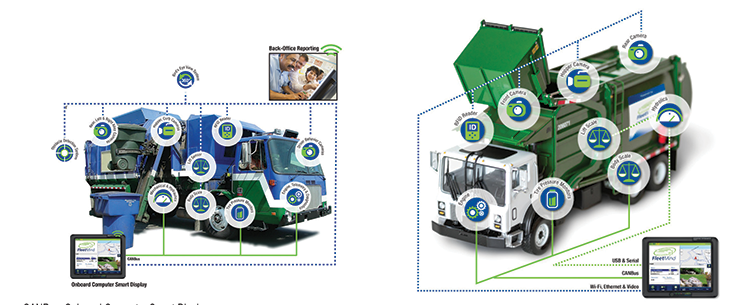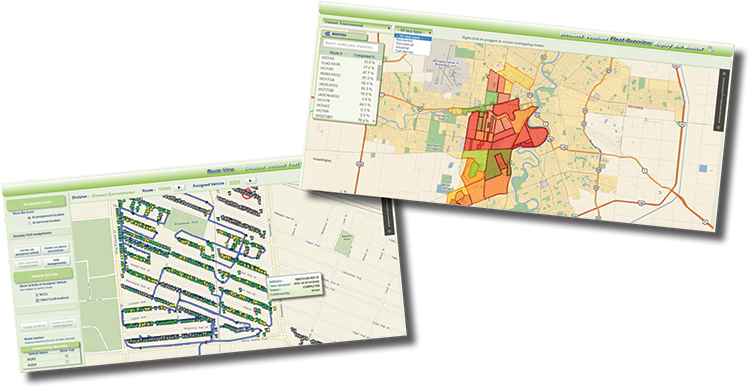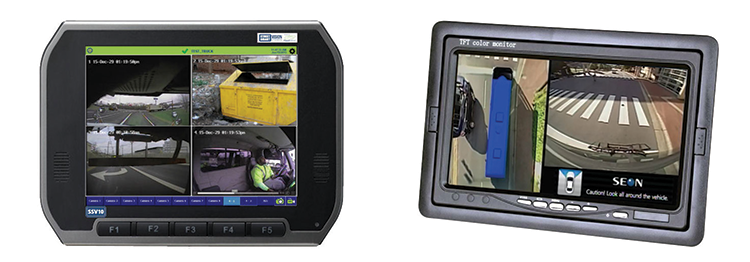How to champion sustainable change in your waste management organization.
By Don Diego Padilla II
Waste collection fleet managers face increasing pressures to deliver collection services that are more efficient, responsive, environmentally friendly, and safe. To do so, trucks need to be smarter by integrating technology to collect and communicate important data regarding routes, drivers, customers, and vehicle systems for a completely transparent fleet operation. As a result, the industry is seeing a sharp rise in demand for “smart” fleets.
The first step towards operating a smart fleet is identifying the need for one. That is easy. We all know that new fleet management technologies can make our fleets smarter, greener, safer, and more productive. The second, and much more difficult, step is making the case to senior managers for the purchase of a smart fleet management system, as this has budget implications.
The third step is to show a sensible path towards implementing a smart fleet management technology system across a waste management organization’s fleet and back-office operations.
Running a smart fleet is a business process change. These changes do not come either easily or overnight. This article will help fleet managers articulate the case for a smart fleet management system and the strategy for its successful implementation and adoption.

Right: USB and Serial, CANBus, Wi-Fi, Ethernet and Video.
Enhance Health, Safety, and Driver Training
Fleet safety is about reducing risk and reinforcing safe driving behavior. With the potential threat of fatalities, serious injury, the direct and indirect cost of collisions, increased insurance premiums, liabilities, and legal impacts, safety initiatives have become a critical concern for fleet managers and senior executives.
With a smart fleet management system, automatic and real-time access to driver scoring results provides the information required to give constructive feedback to drivers, reward safe driving behavior, and provide requisite coaching for any unsafe activity. Through the implementation of this technology, we can more easily monitor driver activity and accurately capture data to deal with driving incidents. Criteria for success includes:
- Provide fleet managers with real-time visibility into driver activity and behavior
- Give all departments access to centralized fleet safety performance data for a completely transparent representation of the fleet’s safety performance
- Track individual driver behavior patterns, weigh, and score data, and alert managers per company policy when risky behavior is reported
- Organize data into real-time reports that can be displayed on a single, organization wide system for all safety data, policies, objectives, and initiatives
Of all the standard fleet safety components, driver monitoring and the ability to easily score driver behavior is of utmost importance. With limited or no visibility into drivers’ behavior, we cannot address or mitigate the issues and cannot deal effectively with at-risk drivers. This lack of visibility directly impacts risk factors, safety records, and operating costs. A smart fleet management solution will provide critical visibility into truck and driver activity.

Above: Reporting capabilities will allow you to evaluate overall fleet and driver activity by collecting relevant and actionable information.
Photos courtey of Safe Fleet.
Fleet Mapping
Fleet mapping provides a real-time map view of vehicles’ positions relative to towns, cities, highways, and streets. Being able to select from several layers will determine the level of detail and plot the vehicle’s position according to reported events. It can further reconstruct the route taken by a driver on any given day, verify any deviations or unscheduled side trips, and view alarm criteria, such as exceeding a specified limit. Required functionality and criteria for success includes:
• Track drivers—all data and events are geo-coded (GPS) with a maximum of position reports to increase precision as required
• Determine how vehicles are being handled
• Determine which drivers generated alarms and where
• Monitor driver speed in relation to speed limits
• Plot locations of alarm occurrences
Reports and Alarms
Reporting capabilities will allow you to evaluate overall fleet and driver activity by collecting relevant and actionable information, including the following required functionality and criteria for success:
- Graphically view route progress and status in real time
- Report the exact route each vehicle took for any day
- Record detailed events during accident situations
- Proactively monitor various Key Performance Metrics (KPM) with customizable deviation thresholds that automate supervisory alarms
- Map overall driving patterns and alert our managers in real-time

Left: A smart fleet management system automatically and continuously records video from all available cameras on the trucks and is available for live streaming or through archive retrieval.
Right: Fleet management systems with smart displays capture real-time information and typically feed this to a back-office dashboard.
Accident Investigation
When accidents or driving incidents occur—and they will—it is essential that you have accurate information to deal with these appropriately. A smart fleet management system automatically and continuously records video from all available cameras on the trucks and is available for live streaming or through archive retrieval. In the event of an accident, a shock detection sensor will automatically capture video and send it to the server from 15 seconds before the accident, and from 15 seconds from after the accident, so that you will have a complete record of what happened. The system also lets drivers record detailed information with a simple press of a button that captures essential data about driving incidents. In addition to tracking driver activity and reports, vehicle reports monitor vehicle usage, including:
• Recorded events
• Recorded alarms
• Vehicle usage graph
Realize Greater Operational Efficiencies
A smart fleet management system will also positively impact operations from dispatch and maintenance, through to billing and administration. Through the successful implementation of the technology, there will be a bottom-line impact over the following key functions:
• Driver and Administrative Labor—ROI analysis can estimate the reduction in minutes per day for administrative paperwork, office support, route time, and route efficiency based on your company’s fleet size, routes, customers, and other operational data. Research has estimated savings in this area can span between $2,500 to more than $5,000 in annual cost improvements for every truck.
• Vehicle Maintenance—From monitoring and managing driving and braking patterns, to ensuring safer driving and reducing idling times, research in this area estimates savings and improvements in this area of up to $2,000 per truck annually.
• Fuel Consumption—By monitoring and managing idling percentages and speeding infractions, and by reducing the amount of unnecessary travel, research estimates your fleet’s projected annual savings on fuel consumption per truck to be as high as $1,500.
• Service Delivery—“Goodwill” benefits of satisfied customers are hard to quantify, as are the benefits of complete 360° visibility into track and driver activity. However, the revenue impact of reducing missed pickups and increasing service delivery can be demonstrated. Additional roll-off benefits and extra commercial revenues can also be calculated to show potential bottom-line impacts to your fleet operations environment.
Improve Sustainability
Underlying both the safety and the operational efficiencies, the implementation of a smart fleet management system will also provide the tools to support a leaner and greener fleet by improving fuel consumption, reducing overall mileage, and reinforcing greener driving behaviors. For example:
• Improving fuel consumption management—Fuel costs account for a major portion of your total fleet operating cost and will vary according to vehicle type, driving style, and mileage. Therefore, managing fuel consumption is a critical part of green fleet management. A smart fleet management system can help reduce fuel consumption and our carbon footprint by optimizing each truck’s routes to reduce time spent on the road and the number of engine hours per day, reduce the amount of fuel burned by the engine as it is being used with idling alarms, and identifying aggressive driving patterns and vehicle maintenance issues so that engines can be repaired before problems escalate.
• Reducing overall mileage—Fleet management systems provide automatic driving directions to the driver and will automatically recalculate the route when a driver selects an out-of-sequence manual stop. This ensures that each route is optimized for time and distance, and reduced overall mileage.
• Supporting driver excellence—Driver behavior is fundamental to fleet efficiencies. Even the most fuel-efficient vehicles will perform poorly with an inefficient driver behind the wheel. Fleet managers need the tools to influence and educate drivers on more emissions-friendly driving approaches. Fleet mapping and monitoring tools will allow fleet managers to work more proactively with drivers to ensure and reinforce better driving behavior.
360° View with Smart Displays and Management Dashboards
Fleet management systems with smart displays capture real-time information and typically feed this to a back-office dashboard. The benefits to waste fleet managers are compelling:
• You will have a vastly improved ability to make decision—A visual presentation of performance measures lets you identify trends in driver behavior, track vehicles and service performance, and measure efficiencies.
• You can better align your organization—By working from a universal set of metrics and a single view into these, all internal functions can track organizational goals and performance.
• You increase operational efficiencies—You save time over running multiple reports, gain total visibility into all information, better manage routes and drivers, and can respond faster to customer service issues.
• You can deal with problems faster—By being able to detect and identify problem areas, you can better manage exceptions, deal with driver or vehicle issues, and ensure route efficiencies.
Keys to Success
The wide-ranging and compelling benefits of implementing a smart fleet management system are well documented. We all know that advances in technology will make our fleets safer, greener, more responsive, and more productive. Yet, every fleet system deployment encounters barriers to adoption and resistance to change management processes. This is simply a fact of life for managers.
Regardless of potential benefits, people do not like change. There are sensible steps we can take to better address the change management process. The following components are intended to help managers create a strategy and approach to facilitate the deployment and adoption of a smart fleet management system.
Commitment from the Team is a Must
Commitment cannot be limited to a select few within the organization. For sure, the senior leadership team needs to demonstrably show their commitment, but commitment needs to be present throughout the organization. Consider this, regardless of how committed the senior leadership team is, if the rest of the employees do not buy in, the project will not be successful. So, how do we gain commitment?
Each manager needs to find out what resonates with their team and build from there. Is the motivator operational improvement, environmental responsibility, competitive advantage, access to information or safety? The likely scenario is that the motivator changes depending on who we are talking to. So, you must build a plan that communicates and resonates with each stakeholder individually if you plan on gaining the level of commitment needed for an organization-wide successful deployment.
Plan Strategically, Execute Tactically
Since you cannot implement everything in one shot, it is important that you plan the execution in a logical manner. When defining the plan, you need to aim at reducing rework, reducing risk, and leveraging previous successes to minimize dead time:
- Break your implementation into short, medium, and long-term time boxes.
- Adopt an iterative approach that incrementally builds out more and more of the strategy.
- Choose iterations that make sense to each manager by business unit, by process, and by function. One to two objectives at a time are ideal.
If you initially identify five to seven improvements that the smart fleet management system offers and you try and implement them all at once, you will most likely fail. It is too much for every stakeholder to absorb at once. Instead, choose the low hanging fruit first, create a campaign and execute one to two initiatives. Once you have experienced success with those two, usually within 90 to 150 days, move on to the next two. And so forth. With this strategy, you will have made four to six improvements over a period of a year and will have great success.
Communicate, Communicate, Communicate—Then Communicate Some More
Communication needs to start when the implementation of a smart fleet management system strategy is at the concept stage. This does not mean that you tell everyone everything all the time. As the implementation progresses, the audience expands and the frequency of communication increases. When adding more channels to the mix, the story becomes more compelling. As the delivery of the solution approaches, more people are informed. Once you have implemented your platform strategy, you will still have to communicate. The nature of the communication will change. It will not be about what is coming, it will be about how to nurture what we have and continually improve upon it.
It is a Marathon, Not a Sprint
This is about getting your team to adopt a “program” mindset. Unlike a project (sprint)—which has an end—a technology platform implementation program (marathon) has no end until your organization “operationalizes” it. The core habits of how your business is conducted will have changed to the degree that that the new technology practices are simply a part of the Standard Operating Procedures.
Define Key Performance Indicators (KPIs) and then Measure Them
When you are developing your overall technology program and strategy, define the KPIs you will be using to determine if you are meeting your objectives. Properly defined metrics prove success, indicate danger, and can help identify adjustments. They are essential when responding to the question, “How are we doing?” Keep three things in mind when developing KPIs for this program:
- They must be directly related to, or supportive of, organizational objectives
- They must be realistic
- They must be actionable
Next, you need to measure them. KPIs are like any other tool—if you do not use them, they are no good to anyone. Put a plan in place to measure KPIs on a regular schedule. Think of it as a maintenance schedule for your car. Also allow for a ramp up time. Rome was not built in a day; neither will you reduce fuel consumption by 8 percent in the first quarter after you go live.
Stakeholder Engagement is Critical
Who are your stakeholders? A stakeholder in this project is any person, group, or system that affects or can be affected by this initiative. Within the context of your implementation, stakeholders break down into participants (active role) and non-participants (passive role). Stakeholder participation is not optional. This does not mean that all stakeholders have an active, hands-on role. It means that you need to find appropriate avenues of engagement, such as focus groups, newsletters, lunch and learns, and so forth. Identify stakeholders early and engage them appropriately.
Change Management
Change management is critically important when implementing a smart fleet management system strategy. Remember that the way that people do their jobs is going to undergo fundamental change. There are two basic streams of change management:
1. People change
2. Process change
People change deals with the human element of change. People in your organization are going to be asked to take on new roles and responsibilities. In some cases, people are going to take on entirely new jobs or may fear losing their jobs. Understandably they may be reluctant, resistant, and even afraid.
Optimizing Waste Collection
More efficient and sustainable waste collection is now considered a fundamental service for future-oriented smart cities. A greater focus on energy savings and safety in waste fleet operations means managers must minimize operations costs while adhering to ever-strengthening safety regulations. Key aspects of fleet management such as fuel consumption, route management, driver performance, and vehicle maintenance are all fundamental to improving fleet operations. Smart fleets can optimize waste collection for connected data sharing between the back office, trucks, and drivers to enable route optimization, full management of container assets, safety, and more efficient, sustainable operations. | WA
A waste industry fleet management veteran, Don Diego Padilla II is Vice President of Sales at Safe Fleet Waste & Recycling, where he spearheads business and customer development activities. Safe Fleet is the largest fleet video supplier in North America with more than six leading video surveillance brands and integrated fleet safety management technologies to help cities work smarter and stay safer. Previously, Don Diego was a Regional Sales Director for Allied Waste (Republic Services), a leading provider of solid waste collection, transfer, recycling, and disposal services in the U.S. His industry white paper on fleet safety garnered a Network Products Guide Award in the “Best White Paper” category. Don Diego has been published in numerous industry magazines and is a frequent speaker at industry forums and regional municipal waste management events. He can be reached at (877) 630-7366 or e-mail [email protected].
Safe Fleet Waste & Recycling (SFWR) is the award-winning technology leader for connected “smart truck” solutions for waste management fleets. SFWR’s technology is derived from a synergy of technologies developed by its parent company Safe Fleet, a leading provider of video and safety solutions for fleets throughout North America and more than 20 years of developing the most advanced fleet management mobile and software solutions specifically designed for waste and recycling collection environments by FleetMind Solutions (a Safe Fleet company). SFWR systems have been installed in thousands of vehicles across North America. Products enable the industry’s top fleets to link their drivers and vehicles to business operations in real-time to ensure optimal productivity, safety, sustainability, profitability, and customer service. FleetMind is now a member of the Safe Fleet family. For more information, call (877) 630-7366, or e-mail [email protected]. To learn more about SFWR’s parent company Safe Fleet, and their portfolio of brands, visit www.safefleet.net.
